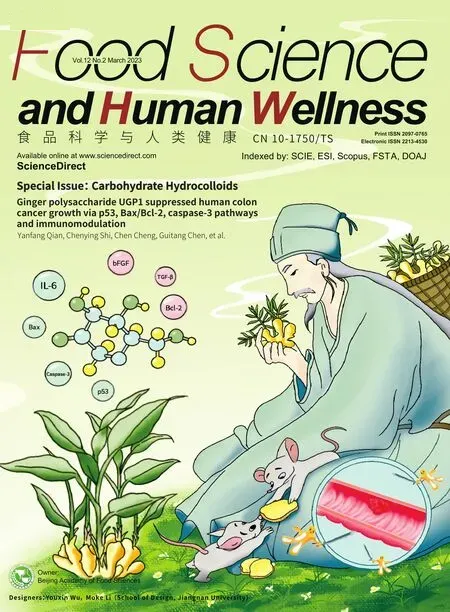In-vitro digestibility,protein digestibility corrected amino acid,and sensory properties of banana-cassava gluten-free pasta with soy protein isolate and egg white protein addition
Adetiy Rchmn,Mrgret A.Brennn,Jmes Morton,Dmir Torrico,Chrles S.Brennn,b
a Department of Wine,Food and Molecular Biosciences,Lincoln University,Christchurch 7647,New Zealand
b Riddet Research Institute,Palmerston North 4442,New Zealand
c Indonesia Institute for Agricultural Research and Development,Jakarta 12540,Indonesia
Keywords:Banana f lour Cassava f lour Gluten-free pasta Digestibility properties Amino acid Sensory evaluation
ABSTRACT Soy protein isolate and egg white protein were added to cassava-banana gluten-free pasta and the effects on the nutritional quality,digestibility properties,protein digestibility corrected amino acid (PDCAA),and sensory acceptance of the pasta was observed.Banana-cassava composite f lour (75:25) was blended with soy protein isolate or egg white protein at the following rates: 0,5,10,and 15 g/100 g f lour.Cooked pasta samples were analysed for total phenolic content (TPC),antioxidant activity,amino acid prof iles,protein content,starch digestibility,protein digestibility and protein digestibility corrected amino acid score (PDCAAS).Addition of both proteins decreased starch digestibility,increased protein digestibility,improved the balance of the amino acid prof ile,and PDCAAS whereas only soy protein isolate enhanced the TPC and antioxidant capacity of the banana-cassava pasta.An egg white protein-fortif ied banana-cassava pasta had better customer acceptance and purchase intent than soy protein isolate inclusion.
1.Introduction
The inclusion of protein into gluten-free products has been studied to improve the physical properties and nutritional quality.Egg white protein is the most common protein source used for enrichment,alongside soy protein isolate as a plant-origin protein source [1].Soy protein isolate has been reported to have functional properties(emulsifier and stabiliser) and bioactivities,such as the reduction in blood pressure,diabetes,and possessing high antioxidant activities [2].
Egg white protein and soy protein isolate inclusion has been reported to promote the physical quality of gluten-free pasta product [3,4].The effect of soy protein isolate on rice gluten-free pasta increased tensile strength and firmness which led to better pasta quality [3].The effect of soy protein isolate on rice-based pasta increased tensile strength and firmness which led to better pasta quality [4].However,there are only a few studies that have evaluated the effect of these protein incorporations on the nutritional quality and digestibility properties of gluten-free pasta.
Nutritional quality assessment includes evaluation of the protein quality of food products and its ability to fulfil an individual’s amino acid requirement.The amino acid requirement is determined by analysing the amino acid score,an efficiency ratio of protein,protein digestibility,the utilization of net protein,the retention of net protein,biological value,and protein digestibility corrected amino acid score (PDCAAS) [5].Several researchers have discussed protein digestibility in gluten-free pasta based on millet [6],faba-oat [7],sorghum,maize,rice,and cassava [8],and brown rice [9].Duta et al.[7]studied the protein digestibility of various commercial gluten-free pasta that also used egg white protein or soy flour in the formulation.However,there is a scarcity of studies that evaluate the PDCAAS of cereal products,especially in gluten-free pasta product.
The PDCAAS has been applied to evaluate the quality of protein in food products as suggested by the FAO/WHO Expert Consultation since 1991 [10].This method corrects amino acid scores by the protein composition and protein digestibility of the tested food products [11].An advanced measurement for protein quality has been recommended using the digestible indispensable amino acid score(DIAAS) that uses true ileal amino acid digestibility for a specific food product.However,the information on the ileal amino acid digestibility is still limited and needs to be determined by aninvivoexperiment [10].
Banana flour utilisation in gluten-free pasta had been evaluated regarding the antioxidant compounds on starch digestibility and showed decreasing in the glycaemic index [12].Banana flour,alongside cassava flour and rice flour are the most common materials used in many studies regarding gluten-free pasta.Banana flour has been reported to have bioactive compounds (phytosterol,total phenolic,and antioxidant activities) that may have anti-cancer activity,reducing human blood level and cholesterol [13].Cassava flour utilisation in gluten-free pasta is limited by its low protein content and starch characteristics [14].A previous study showed a portion of cassava flour in gluten-free pasta formulation that gave optimum quality is 25 g/100 g [15].
Beyond the nutritional values of food products,a sensory evaluation can give a comprehensive evaluation of how an effort to provide healthy products can affect consumer acceptance.Detchewa et al.[3]found that a 5% soy protein isolate addition to rice flour pasta had the best sensory acceptability (6.16 out of 9)compared to other rice pasta formulations (0% -10% soy protein isolate addition).However,this was still less accepted than the commercial wheat pasta (7.46 out of 9).Zandonadi et al.[16]revealed that gluten-free pasta made of unripe plantain and 31% egg white had no difference in sensory acceptance compared to a wheat pasta as a control (6.13 and 5.93 out of 9,respectively).
There is scarce research addressed on the digestibility properties,amino acid composition and sensory properties assessment of glutenfree pasta,notably using banana-cassava flour with protein addition.This study aimed to evaluate total phenolic content,antioxidant activities,amino acid composition andinvitrostarch and protein digestibility,alongside the PDCAAS and sensory evaluation of banana-cassava gluten-free pasta enriched with egg white protein and soy protein isolate.
2.Materials and methods
2.1 Materials
Banana flour and cassava flour were procured from Food Compass Ltd.(Auckland,New Zealand).Egg white protein powder(80% protein) and soy protein isolate (91% protein) were obtained from Nothing Naughty Ltd.(Tauranga,New Zealand) and Bulk Powder Ltd.(Braeside,Australia),respectively.Durum semolina as a pasta control ingredient was obtained from Sun Valley (Auckland,New Zealand).
2.2 Pasta preparation
Banana flour and cassava flour were blended in a ratio of 75:25.This composite flour then was added with 0%,5%,10% and 15% of soy protein isolate or egg white of flour (m/m).A 100% semolina pasta was prepared as a control.An MPF15N235M pasta-making machine (Fimar,Ravenna,Italy) was used to produce pasta with a spaghetti die (20 holes,2.25 mm die hole diameter).
All ingredients (300 g) were put in the pasta machine and mixed for 4 min.A 70% water at 100 °C was added while mixing run for another 20 min [15].A pasta control was prepared by mixing semolina flour with 30% water at 41 °C [17].A mixture was then moulded in spaghetti die.Before analysis,pasta sample was cooked on its optimum cooking time in boiling water (100 °C) [18].
2.3 Sample preparation for total phenolic content (TPC) and antioxidant capacity
A pasta sample was extracted for TPC and antioxidant capacities followed method by Hossain,Brennan,Mason,Guo,Zeng and Brennan [19].A 20 mL of 70% methanol was added to the dry sample powder (2 g) and stirred at room temperature (approximately 25 °C)in the multi-stirrer overnight.A supernatant then was separated by centrifuge (3 000 ×gfor 10 min) and put into 15 mL falcon tubes and stored at −20 °C until the day of analysis.
2.4 TPC
The TPC was measured by Folin-Ciocalteau’s method [20,21].A 500 μL sample was mixed with 2.5 mL of Folin-Ciocalteau reagent(0.2 mol/L) and 2.0 mL of 7.5 g/100 mL sodium carbonate in the falcon tubes.The mixture was mixed and kept for 2 h in the darkroom.The absorbance of the mixture was recorded using Spectrophotometer model V-1200 (VWR International Co.,Pennsylvania,USA) at wavelength of 760 nm.A standard curve was obtained from gallic acid (0–200 μg) in methanol.The results were presented as mg gallic acid equivalents (GAE) per 100 g dry material (DM).
2.5 Ferric reducing antioxidant power (FRAP)
The FRAP value was determined according to Khanizadeh,Tsao,Rekika,Yang and DeEll [22].A FRAP reagent was prepared by mixing a reagent made of 10 mmol/L TPTZ,a 40 mmol/L HCl,and a 20 mmol/L FeCl3·7H2O (10:1:1,V/V) with acetate buffer (300 μmol/L,pH 3.6).A 2.5 mL FRAP reagent was added to a 250 μL sample extract.The absorbance was read after 2 h incubation at 37 °C at 593 nm.A series of iron (II) sulphate (FeSO4·7H2O) solution(0–200 μmol/L) was prepared as a standard.The FRAP values were presented as mmol Fe2+/100 g DM.
2.6 A radical scavenging capacity of 2,2’-azino-bis(3-ethylbenzothiazoline-6-sulfonic acid) (ABTS)
The ABTS value was evaluated following Cai et al.[23].ABTS+·reagent was made of an ABTS stock reagent (7 mmol/L in water)reacted with 2.45 nmol/L potassium persulfate for 16 h at room temperature (25 °C) in the darkroom.A pH 7.4 phosphate buffered saline (PBS) was used to set ABTS+· reagent absorbance to 0.70 ± 0.02 at a wavelength of 734 nm on the day of analysis.A 300 μL sample extract was mix with 3 mL ABTS+· solution in a cuvette and kept at room temperature (25 °C) for 6 min.The absorbance of the mixture was recorded at 734 nm.Trolox (0–200 μmol/L in methanol) was prepared to plot a standard curve.The ABTS values were counted as μmol Trolox equivalents (TE)/100 g DM.
2.7 Starch digestibility
A 2–5 mm size of cooked pasta (5 g) was prepared for starch digestibility assessment.The reducing sugars released at 0,20,60 and 120 min were observed following method by [24].A 2.5 g of cooked pasta sample was placed in 60 mL plastic container and added with 30 mL of distilled water.The mixture was placed on a pre-heated magnetic heated stirring block (IKAMAG RT15,IKA 1 -WERKE Gmblt&Co.,Staufen,Germany).The temperature of the mixture was held at 37 °C for 10 min.A 1 mL of 10% solution in 0.05 mol/L HCl was added into the mixture while stirred at 130 r/min at 37 °C for 30 min.1 mL of aliquot was taken and placed in a test tube containing 4 mL methanol (time 0).A 0.1 mL amyloglucosidase was put into the digestion container followed by 5 mL of 2.5% pancreatin in 0.1 maleate buffer solution.A 1 mL aliquot was collected after 20,60,and 120 min and placed alongside 4 mL methanol in a plastic tube.Reducing sugar content was analysed using 3.5-dinitrosalicylic acid(DNS).A graph of glucose release was measured against time and area under the curve (AUC) was analysed as a total trapezoid’s area.
2.8 Protein content
Total nitrogen content (%) was traced using element analyser Vario MAX CN (Elementar Analysensystememe GmbH,Langenselbold,Germany).A 6.25 multiplication was calculated to produce crude protein content from the total nitrogen content [25].
2.9 Protein digestibility
The protein digestibility was evaluatedinvitrothrough a multienzyme assay for a cooked pasta sample [26].A sample with a constant protein content was mixed with distilled water (6.25 mg/mL).A 0.1 mol/L HCl and/or 0.1 mol/L NaOH was used to adjust to pH 8 and then set at 37 °C.A solution consisted of three enzymes was prepared by mixing trypsin,protease and chymotrypsin (1.6,1.3,and 3.1 mg/mL,respectively) on the day of analysis.A 50 mL protein sample suspension was added with 5 mL of multienzyme solution at 37 °C.A digital pH meter (S20 Seven EasyTM,Mettler Toledo,USA) was used to record pH change per minute in 10 min.The protein digestibility (Y)was determined in percentage following the equation [24]:

whereXis the pH change in 10 min.
2.10 Amino acid profiles, amino acid score (AAS) and protein digestibility-corrected amino acid score (PDCAAS)
The profiles of the amino acid (AA) were analysed using highperformance liquid chromatography (HPLC) Agilent 1100 series(Agilent Technologies,Walbronn,Germany) [27].The dried cooked pasta was mixed with 6 mol/L HCl (hydrochloric acid) and put in a 110 °C oven for 20 h.The separation of amino acid used a 150 × 4.6 mm HPLC column,C18,3uACE-111-1546,(Winlab,Glasgow,Scotland).The flow rate was 0.7 mL/min at 40 °C.AnO-phethaldialdehyde (OPA) as a fluorescence derivative reagent was used to detect primary amino acids,while secondary amino acids were scanned by FMOC (9-fluorenylmethyl chloroformate).The primary amino acids used a 335 nm excitation fluorescence detector with an emission of 440 nm.At 22 min,the excitation and emission were set to 260 nm and 315 nm,respectively for secondary amino acids detection such as proline.The amino acids content was presented in mg of AA per g protein.
The AAS was determined by dividing the correspondences AA(mg/g protein) by the AA recommendation scores (mg/g protein)for adults (>18-year-old) including histidine (His),isoleucine (Ile),leucine (Leu),lysine (Lys),methionine (Met)+cysteine (Cys),phenylalanine (Phe)+tyrosine (Tyr),threonine (Thr),and valine(Val),with the following scores: 15,30,59,45,22,38,23,and 39,respectively [28].The PDCAAS was obtained by multiplying the protein digestibility percentage by the lowest AAS value.Maximum PDCAAS value is 1.00 [28].
2.11 Sensory evaluation
Sensory analysis was determined using an affective quantitative method according to Zandonadi et al.[16]and Gao et al.[29].The trial was conducted under approval permission of Lincoln University human ethic committee.Sensory tests were using a hedonic scale of 9 points (1_extreme dislike to 9_extreme like).The number of consumer panels were 37 untrained panellists (student and staff at Lincoln University) who are not averse to pasta product.The attributes were appearance,aroma,flavour,texture,and overall quality of the product.Cooked samples include control were coded with 3-digit random numbers and served on a white plastic plate at the same time.Panellist received 20 g of each fresh cooked pasta sample and was advised to drink water between the sample observation.
2.12 Statistical analysis
All analysis was performed in triplicate unless otherwise stated.The ANOVA (analysis of variance) was calculated in Minitab 18(Minitab Pty Ltd,Sydney,Australia).The differences of all pasta samples were evaluated statistically by one-way analysis of variance(ANOVA.) A general linear model ANOVA was applied to determine the effect of protein type and protein level addition for gluten-free pasta (semolina pasta excluded).Tukey’s post-hoc analysis (P<0.05)was used to show differences among the samples.
3.Results and discussion
3.1 TPC and antioxidant capacities
A comparison of TPC and antioxidant activities (FRAP and ABTS) of banana-cassava gluten-free pasta and semolina pasta showed significant differences (Table 1).The banana-cassava pasta had a higher TPC,ABTS,and FRAP content than semolina pasta.A high TPC,ABTS,and FRAP in banana flour produced high TPC and antioxidant capacities of gluten-free pasta even when it was mixed with cassava flour that had a low value for TPC and antioxidant capacities.This showed that 25% cassava flour incorporation into the banana gluten-free pasta formulation did not give a significant deterioration of TPC or antioxidant ability in gluten-free pasta.These results met agreement with the previous study regarding banana pasta evaluation on nutritional qualities including TPC and antioxidant activities [30].
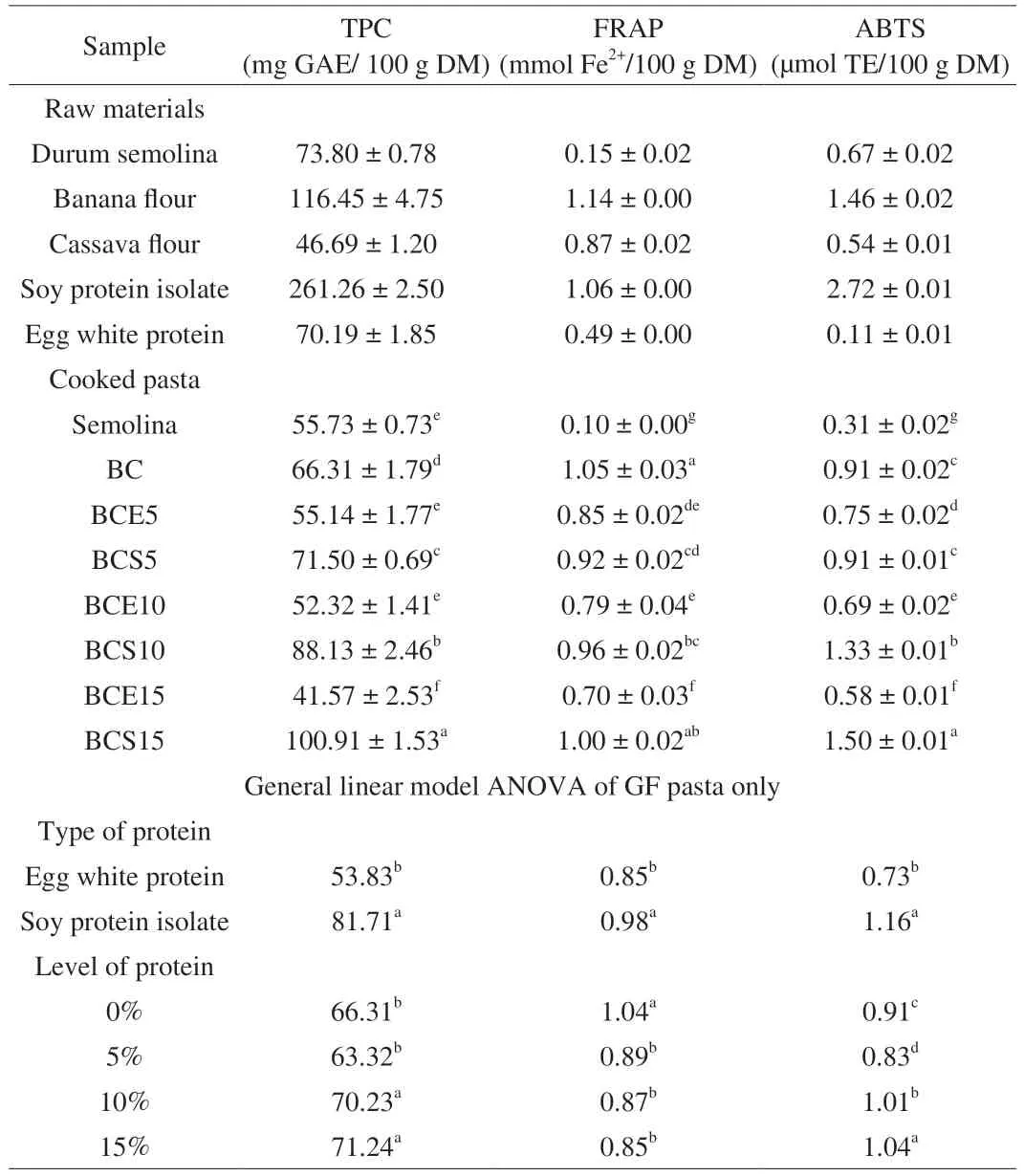
Table 1 TPC,FRAP and ABTS values of raw materials and cooked pasta.
The type of protein addition gave a significant difference in TPC and antioxidant capacities to gluten-free pasta.Soy protein isolate increased the TPC,FRAP,and ABTS content of banana-cassava pasta,egg white protein reduced the TPC,FRAP and ABTS values with higher-level inclusion,this is because soy protein isolate had a higher TPC and antioxidant activities than egg white protein.Egg white protein exhibited a lower TPC and antioxidant capacities compared to banana flour.Soy protein isolate has high antioxidant ability mainly due to its amino acid profiles,the length of the peptide chains,sequence,and interaction of the peptide-liposomal membrane [2,31].
3.2 In vitro starch digestibility
Pasta made from cassava flour and banana flour without any protein enrichment showed no difference in total area under the curve(AUC) to semolina pasta,indicating that similar level ofinvitrostarch digestibility (Fig.1).Both protein sources inclusion reduced the starch digestibility of the gluten-free pasta significantly.A lower starch digestibility may be due to protein addition (oat protein isolate,faba protein isolate,and chickpea protein isolate) to gluten-free pasta also was observed by other studies based on oat starch [7],and rice flour [32].
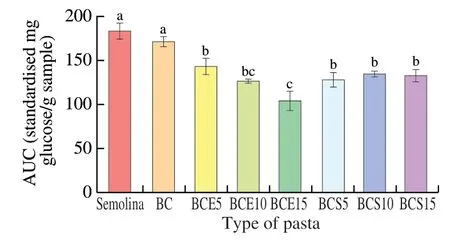
Fig.1 Area under curve (iAUC) values of cooked pasta.Different letters on the top of the bars represent significantly different (P <0.05),based on Tukey’s test.
An increasing level of egg white protein addition led to lower starch digestibility in gluten-free pasta,while the level of soy protein isolate addition (5%,10%,or 15%) did not give any differences.These results showed that egg white protein gives a greater effect in reducing the starch digestibility of banana-cassava pasta then soy protein isolate inclusion.Egg white protein created a stronger protein-starch network compared to soy protein isolate that inhibits starch enzymatic degradation.The stronger protein-starch interaction can be assumed from better cooking qualities and texture properties of gluten-free pasta with egg white protein then soy protein isolate as reported in a previous study [18].Similar results have been found regarding the effect of different types of protein (oat protein concentrate and faba protein concentrate) and level of protein addition(18% and 35%) on the starch digestibility of oat starch-based glutenfree pasta.Oat protein isolate inclusion reduced starch digestibility compared to the gluten-free oat pasta control,but the different addition levels (18% and 35%) did not have a different hydrolysis index or glycaemic index [7].This indicates that various types of protein might have a specific/optimum range of addition to reduce the starch digestibility of pasta samples.
3.3 In vitro protein digestibility
Protein content,protein availability,and protein digestibility of gluten-free pasta samples varied and differed to the control,as shown in Table 2.Pasta samples based on banana flour and cassava flour had a lower protein content (1.79%),lower protein digestibility (70.43%),and lower protein availability (2.24%) compared to semolina pasta (12.26%,85.81% and 10.52%,respectively).The protein incorporation increased the protein content significantly,followed by the increase of protein digestibility and protein availability.Protein addition improved protein digestibility as more protein available in gluten-free pasta formulation.Native protein in banana and cassava pasta may have poor protein-starch bonding,but it may have strong interaction with a phenolic compound in banana and cassava flour that inhibited enzymatic reaction to digest the native protein.The addition of protein sources created more starch-protein bonding in pasta formulation,but it may disrupt the phenolic compound bound resulted in increasing protein digestibility [26].Egg white protein created a stronger protein-starch bonding that made more difficult to digest compared to soy protein isolate.Both types of protein raised the protein digestibility as there was proportionately more protein in the gluten-free pasta.Other studies have also reported protein digestibility enhancement in gluten-free pasta incorporated with protein sources [7,32,33]and in wheat-based pasta with plant protein isolate (soy,pea,and corn protein isolate) addition [34,35].
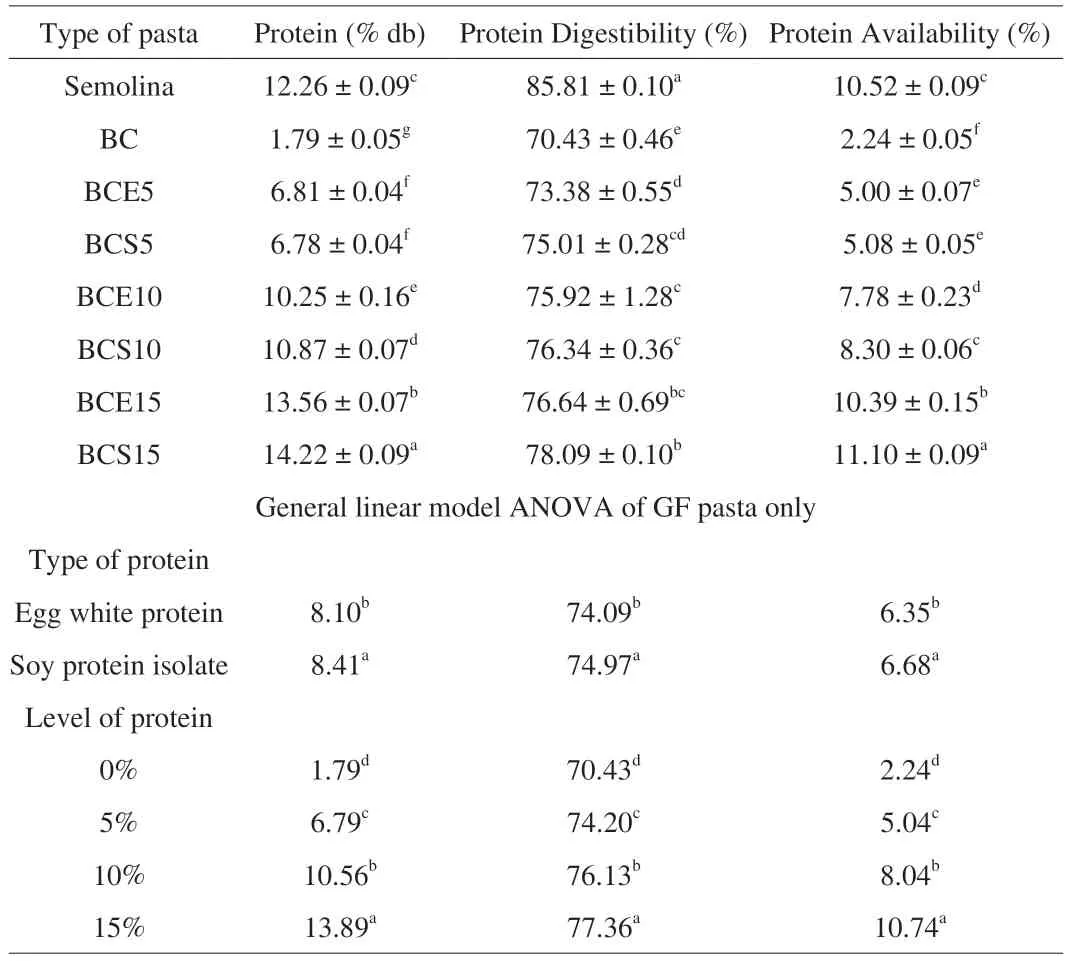
Table 2 Protein content,digestibility,and availability of gluten-free pasta and semolina pasta.
Protein digestibility was higher in banana-cassava pasta with soy protein isolate then egg white protein addition.This is because the soy protein isolate forms a weaker starch-protein bonding in the pasta.Laleg et al.[36]found that wheat pasta enriched with faba protein had a higher protein digestibility (46%) compared to egg protein(39%) which was also related to a weaker protein network in the faba enriched pasta (18% covalent link) than in the egg protein powder enriched pasta (32% covalent link).
3.4 PDCAAS
Semolina pasta had four EAAs that do not meet the EAA daily consumption recommendation (Table 3) namely Ile,Leu,Lys,and Val.Banana-cassava gluten-free pasta EAA composition (Table 3),only had 3 out of 8 groups of EAA that met the daily recommendation(His,Thr,and Lys).However,a 5% protein inclusion (soy protein isolate or egg white protein) to banana-cassava gluten-free pasta was enough to improve the amino acid profiles to meet the EAA recommendation for the daily diet [28].Egg white protein raised Val content,while soy protein isolate led to a higher level of His.

Table 3 Amino acid profiles of semolina pasta,banana-cassava pasta,and the recommendation of daily consumption of human adult (mg of amino acid per g protein).
Chen et al.[2]reported that amino acid composition affected the antioxidant activities,especially Tyr,Cys,Met,His,Lys,and Phe content.Banana-cassava pasta had a rich His and Lys composition that may contribute to its high antioxidant properties.The soy protein isolate-enriched pasta had a high content of amino acids that have known antioxidant activities (Cys,Met,His,and Lys) [2].This led to the soy protein isolate enriched pasta having higher antioxidant capacities compared to the egg white protein-enriched gluten-free pasta.
The PDCAAS of gluten-free pasta enriched with egg white protein or soy protein isolate were higher than semolina pasta or gluten-free pasta without any protein addition (Table 4).Semolina pasta had PDCAAS of 0.63 with Val as a limited amino acid score(AAS).Banana-cassava gluten-free pasta had the lowest PDCAAS(0.04) that was also limited by cysteine and Met (AAS 0.06).The protein inclusion enhanced PDCAAS ranged from 0.68 to 0.94 and was higher than the semolina pasta score.Egg white protein-enriched banana-cassava pasta had a better PDCAAS (0.70) than soy protein isolate-enriched banana-cassava pasta (0.62).The level of protein addition (5% -15%) did not have a significant effect on PDCAAS.These results showed that the 5% protein addition was the optimum level to gain a good quality of protein in banana-cassava gluten-free pasta.Therefore,adding 5% egg white protein proves to be the most effective enrichment.
3.5 Sensory properties
The sensory evaluation result of banana-cassava pasta with protein addition showed significant acceptance compared to semolina pasta(Table 5).All the gluten-free pasta had lower overall scores (4.73 to 5.65 out of 9.00) compared to semolina pasta (7.19 out of 9.00).The texture of gluten-free pasta (5% and 15% egg white protein inclusion)was the only attribute that had a similar score with semolina pasta.
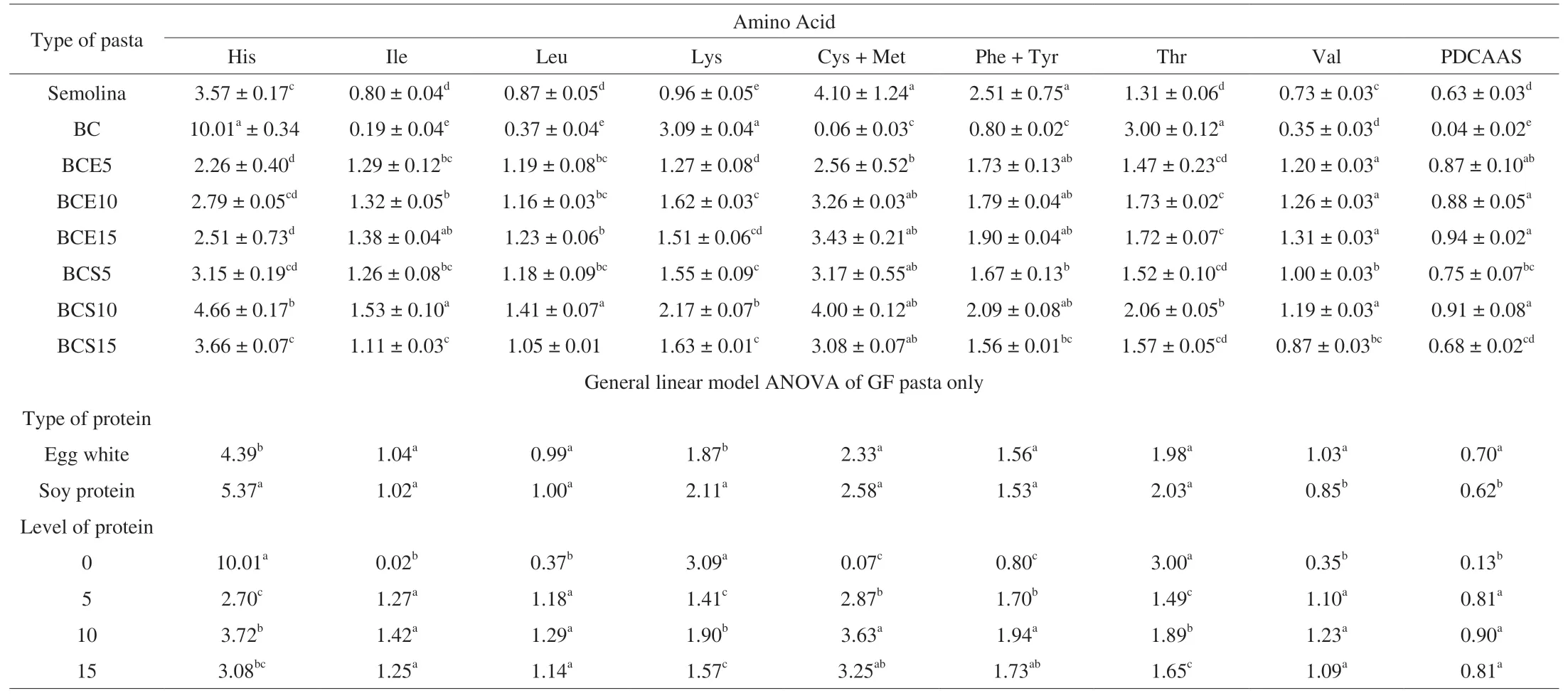
Table 4 AAS (mg per g protein) and PDCAAS of semolina pasta and banana-cassava pasta.

Table 5 Sensory properties of semolina pasta and banana-cassava pasta.
Egg white protein-enriched banana-cassava pasta had a better overall perception than the soy protein isolate-enriched pasta (5.57 and 4.73 out of 9.00,respectively).Other research into the sensoryqualities of banana pasta enriched with 31.5% egg white showed a similar overall score of 6.13 out of 9.00 [16].Detchewa et al.[3]reported a better overall sensory acceptance of soy protein isolate addition (0% -10%) in rice gluten-free pasta (overall acceptance of 6.10 to 6.60 out of 9.00,but this was still lower than the semolina pasta control (8.00 out of 9.00).A 15% protein addition did not give a better overall acceptance than a 5% protein addition in glutenfree pasta.These results illustrate that banana-cassava gluten-free pasta incorporation with egg white protein had moderate sensory acceptance (neither like nor dislike to slightly like).Soy protein incorporation in gluten-free pasta had low overall perception (slightly dislike to neither like nor dislike).
Panellists gave a higher score for appearance,texture,and overall liking of egg white protein-enriched pasta compared to soy protein isolate-enriched pasta.There were no significant differences for aroma,flavour,bitterness,and aftertaste of both protein enrichment in gluten-free pasta.The levels of protein addition (5% and 15%) did not show any different acceptance of all sensory test attributes.
Table 6 shows the overall texture and flavour perception varied for each of the pasta samples.Egg white protein,either 5% or 15% addition,showed a good perception (just about right) of texture (73% and 70%,respectively) and flavour (62% and 59%,respectively).Different texture and flavour perception were found for soy protein isolate addition.More than half panellists (54%) said that the texture was too soft texture with 15% soy protein isolate addition,and 46% panellists thought that texture of the same sample was just about right.The texture perception seems to be related to the textural properties of cooked pasta,especially for the extensibility results [18].The previous study reported that banana-cassava pasta incorporation with egg white protein had similar value (17.33 to 34.39 g) to semolina pasta(34.45 g),while soy protein isolate inclusion had lower extensibilities(9.54-23.06 g) that resulted in a too soft texture perception [18].For the flavour of soy protein addition,46% panellists said that 5% soy protein addition was too weak,and 51% panellists scored a just about right flavour for banana-cassava pasta with 15% soy protein isolate inclusion.

Table 6 Overall texture and flavour perception and purchase intent of pasta samples.
Purchase intent (Table 6) of semolina pasta had a high score(81% of panellists were willing to buy).Banana-cassava pasta with egg white protein inclusion had a moderate purchase intent (49% and 46%),while soy protein isolate had a low score of panellists wanted to buy the products (19% and 16%).These showed that banana-cassava pasta,especially with egg white protein inclusion,had the potential to enter the market.
4.Conclusion
The addition of a protein source improved the nutritional quality(total phenolic content,antioxidant activities,and amino acid profiles)of the gluten-free banana-cassava pasta and when compared to semolina pasta.It also increased protein digestibility,reduced starch digestibility,and enhanced PDCAAS.Soy protein isolate was more effective than egg white protein at improving the TPC,antioxidant capacities,enhanced amino acid profiles,and increasing protein digestibility.Egg white protein supplementation gave a lower starch digestibility and had a better sensory acceptance then soy protein isolate inclusion.Future studies to improve the sensory acceptability of banana-cassava gluten-free pasta are needed to make it comparable to semolina pasta.
Declarations of competing interests
The authors declare that they have no competing interests.
Ethical Approval
The sensory evaluation was conducted under Lincoln University Human Ethics Committee (HEC) for Ethical Approval for a Project Involving Human Participants (Application No: 2020-10).
- 食品科学与人类健康(英文)的其它文章
- Colloidal nanoparticles prepared from zein and casein:interactions,characterizations and emerging food applications
- Biological factors controlling starch digestibility in human digestive system
- Preparation methods,biological activities,and potential applications of marine algae oligosaccharides: a review
- Development of hyaluronic acid-based edible film for alleviating dry mouth
- Mushroom β-glucan and polyphenol formulations as natural immunity boosters and balancers: nature of the application
- Preparation of multicore millimeter-sized spherical alginate capsules to specifically and sustainedly release fish oil

